Scientists get a rare view of a type Ia supernova magnified 50 times
For the first time, astronomers have caught a type Ia supernova being magnified by more than 50 times and split into four images in the night sky thanks to gravitational lensing.
The discovery, described in the journal Science, could help scientists get a better handle on the rate of expansion of the universe and shed light on the mysterious, invisible mass in the universe known as dark matter.
“Once this grows into a larger sample, then certainly you can use this to constrain gravitational lensing and dark matter and Einstein’s general theory of relativity — all of these,” said study co-author Mansi Kasliwal, an astronomer at Caltech.
As it travels through the universe, light is squeezed, stretched, bent, scattered and filtered before it reaches our telescopes. These alterations allow us to suss out the nature of the contents of the universe.
But oftentimes, this complex mix of changes makes it devilishly difficult to sort out what’s really happening to a given star, supernova or other astrophysical object.
For example, a star that seems dim could be bright and faraway, or dim and nearby. This is where Type Ia supernovae come in. These stellar deaths — which happen when a white dwarf in a binary system picks up too much mass from its companion star — always peak at the same luminosity. So if astronomers see a dim type Ia, they know it’s far; if they see a bright one, they know it’s nearby.
But far enough away, these “standard candles” become increasingly difficult to see and study. So scientists have been looking for a type Ia whose light has been gravitationally lensed — magnified by a massive object, such as a galaxy, sitting between the supernova and Earth’s telescopes. The artificial brightening caused by gravitational lensing would allow researchers to study far more distant type Ia explosions in order to learn more about the faraway universe.
After all, type Ia supernovae have actually helped scientists to understand and measure the accelerating expansion of the cosmos — which earned the Nobel Prize in physics in 2011. That’s because the astronomers were able to compare the actual distance as measured by the supernovae’s brightness to their redshift, the stretching of starlight that signals how fast a distant object is moving, largely because of the expanding universe.
Ever since the phenomenon of gravitational lensing was predicted by Albert Einstein, plenty of lensed objects have been discovered. In that time, there also have been a decent number of type Ia supernovae spotted in the heavens. Finding a gravitationally lensed type Ia, however, has proved elusive.
But on Sept. 5, the intermediate Palomar Transient Factory at the Palomar Observatory in San Diego spotted a strangely bright object appear in the night sky; the Global Relay of Observatories Watching Transients Happen, which calls on an international network of telescopes, followed up soon after. The object also was studied using NASA’s Hubble Space Telescope and the W.M. Keck Observatory in Hawaii.
“It just made no sense because the spectroscopic redshift was so high that that would make this event intrinsically over-bright — just too bright to be a type Ia supernova even though the spectrum looked just like a type Ia supernova,” Kasliwal said. “When I saw that spectrum I was completely baffled. I just didn’t know how to make sense of it. And then [lead author] Ariel Goobar, my colleague, said, ‘Well, what if this was lensed?’ ”
The supernova, iPTF16geu, turned out to be magnified and split into four distinct images by a galaxy with the mass of 10 billion suns and a radius of close to 3,000 light-years. The stellar explosion lies about 4.4 billion light-years from us; the galaxy, in the same line of sight, is about 2 billion light-years away.
The light coming from this lensed supernova, and others like it, should give astronomers fresh insight into dark matter and Einstein’s general theory of relativity. The differences in arrival times of the four different images could help researchers perform high-precision measurements of the universe’s expansion rate.
“It took a thousand tries to find one, but we are hopeful,” Kasliwal said. “It’s the first but should definitely not be the last.”
The search is soon to get a major upgrade. Scientists are in the process of putting a new, larger camera at the Palomar Observatory, which should make the search process go about 10 times faster.
Follow @aminawrite on Twitter for more science news and “like” Los Angeles Times Science & Health on Facebook.






